Trout Fishing and the Trouth
“Some water is so clear that trout will swim to your fly, your silhouette all too visible to them as they gaze up and through the water and air, and will inspect your tying job, the amount of head cement you applied, observe whether you used a good stiff hackle or whether you used natural or synthetic dubbing material, nose the thing, then swim away. Occasionally, one will take the fly, not caring that a bit of thread is visible where the tail is tied down, not even caring that your tippet is corkscrewed. A trout hiding behind a rock in fast, muddy water might or might not take a nymph fished deep through the riffle. For all the aggravation a trout can cause, it cannot think and does not consider you. A trout is very much like truth; it does what it wants, what it has to.”
- Percival Everett, Erasure
If These Lodge Walls Could Talk: Ilahe Lodge on the Rogue River
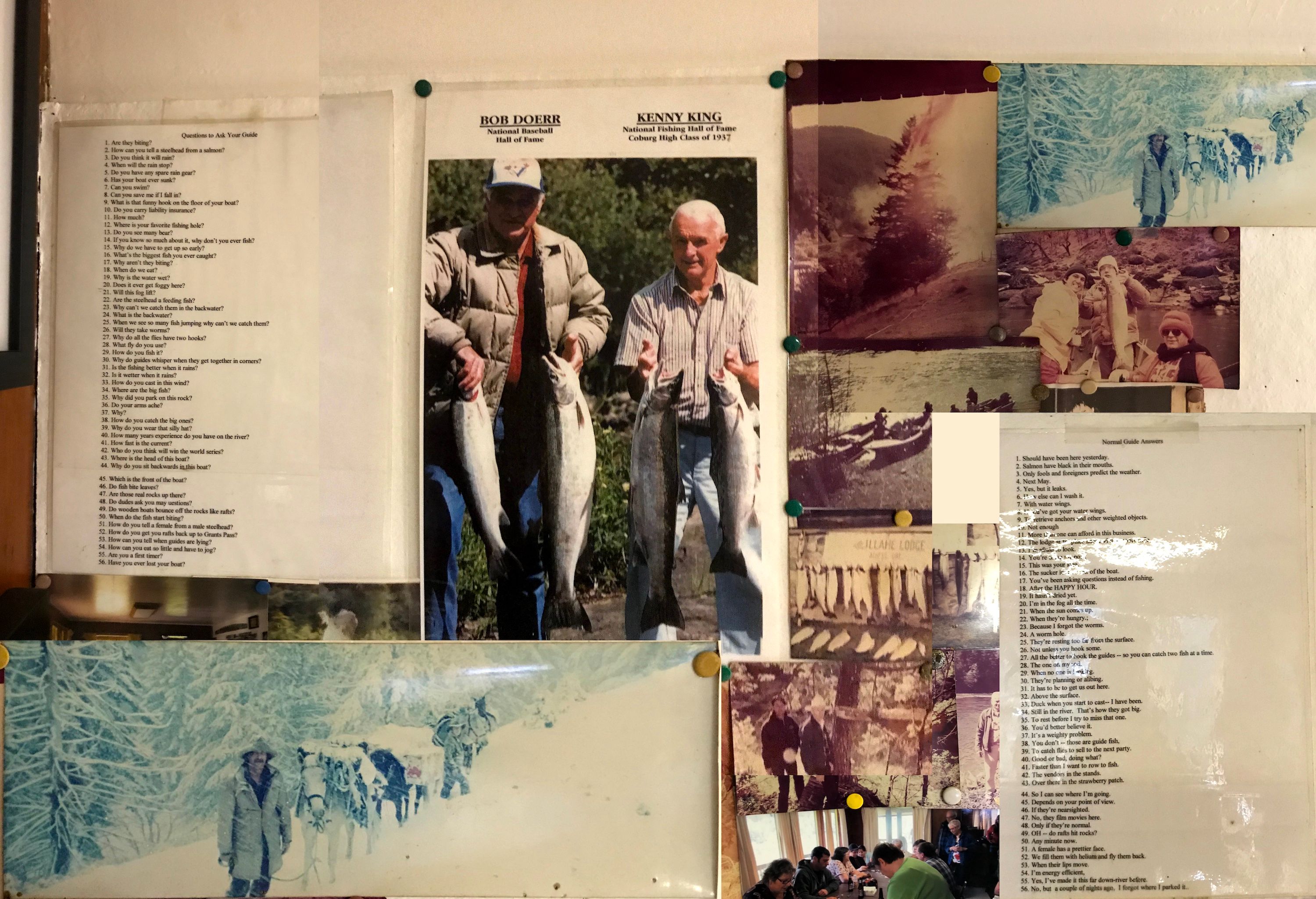 Just a few of the images from the walls of the great Ilahe
Just a few of the images from the walls of the great Ilahe
I was browsing the summer ’23 issue of The Drake and came upon a few old guide chestnuts, combining the ignorance of the customers, (“dudes”, or “custies” in river rafting lingo), the grind of the job across a season, and the general cynicism that comes when you turn something you love into something that pays the bills.
Some of these I’ve heard before (“Hey, that’s the truck—-does this river run in a circle?), some are new to me. (”Guiding is awesome. All you do is spend money and get skin cancer.”)
But they reminded me of Questions to Ask Your Guide, a two-part set of posters I saw on the wall of the Ilahe Lodge on the Rogue. I get the sense it was as much a training program for new guides as intended to help dudes, especially considering the Ilahe, near Foster Bar, is about the third night down the river, so if you’re a clueless passenger you’ll have probably already revealed yourself so.
Anyway, here they are, dated language and all. [Check out the Ilahe if you can, it’s timeless[(https://illahelodge.com/).
Questions to Ask Your Guide
- Are they biting?
Should have been here yesterday. - How can you tell a steelhead from a salmon?
Salmon have black in their mouths. - Do you think it will rain?
Only fools and foreigners predict the weather. - When will the rain stop?
Next May. - Do you have any spare rain gear?
Yes, but it leaks. - Has your boat ever sunk?
How else can I wash it. - Can you swim?
With water wings. - Can you save me if I fall in?
If you’ve got water wings. - What is that funny hook on the floor of your boat?
To retrieve anchors and other weighted objects. - Do you carry liability insurance?
Not enough. - How much?
More than anyone can afford in this business. - Where is your favorite fishing hole?
The lodge at … - Do you see many bear?
I’m afraid to look. - If you know so much about it why don’t you ever fish?
You’re using my rod. - Why do we have to get up so early?
This was your idea. - What’s the biggest fish you ever caught?
The sucker in the front of the boat. - Why aren’t they biting?
You’ve been asking questions instead of fishing. - When do we eat?
After the HAPPY HOUR. - Why is the water wet?
It hasn’t dried yet. - Does it ever get foggy here?
I’m in the fog all the time. - Will this fog lift?
When the sun comes up. - Are the steelhead a feeding fish?
When they’re hungry. - Why can’t we catch them in the backwater?
Because I forgot the worms. - What is the backwater?
A worm hole. - When we see so many fish jumping why can’t we catch them?
They’re resting too far from the surface. - Will they take worms?
Not unless you hook some. - Why do all the flies have two hooks?
All the better to hook the guides — so you can catch two fish at a time. - What fly do you use?
The one on my rod. - How do you fish it?
When no one is looking. - Why do guides whisper when they get together in corners?
They’re planning or alibiing. - Is the fishing better when it rains?
It has to get to get us out here. - Is it wetter when it rains?
Above the surface. - How do you cast in this wind?
Duck when you start to cast — I have been. - Where are the big fish?
Still in the river. That’s how they got big. - Why did you park on this rock?
To rest before I try to miss that one. - Do your arms ache?
You’d better believe it. - Why?
It’s a weighty problem. - How do you catch the big ones?
You don’t — those are guide fish. - Why do you wear that silly hat?
To catch flies to sell to the next party. - How many years experience do you have on the river?
Good or bad, doing what? - How fast is the current?
Faster than I want to row to fish. - Who do you think will win the world series?
The vendors in the stands. - Where is the head of this boat?
Over there in the strawberry patch. - Why do you sit backwards in this boat?
So I can see where I’m going. - Which is the front of the boat?
Depends on your point of view. - Do fish bite leaves?
If they’re nearsighted. - Are those real rocks up there?
No, they film movies here. - Do dudes ask you many questions?
Only if they’re normal. - Do wooden boats bounce off the rocks like rafts?
OH — do rafts hit rocks? - When do the fish start biting?
Any minute now. - How do you tell a female from a male steelhead?
A female has a prettier face. - How do you get you rafts back up to Grants Pass?
We fill them with helium and fly them back. - How can you tell when guides are lying?
When their lips move. - How can you eat so little and have to jog?
I’m energy efficient. - Are you a first timer?
Yes, I’ve made it this far down-river before. - Have you ever lost your boat?
No, but a couple of nights ago I forgot where I parked it.
Pick up the Summer ’23 issue of The Drake for more guide humor
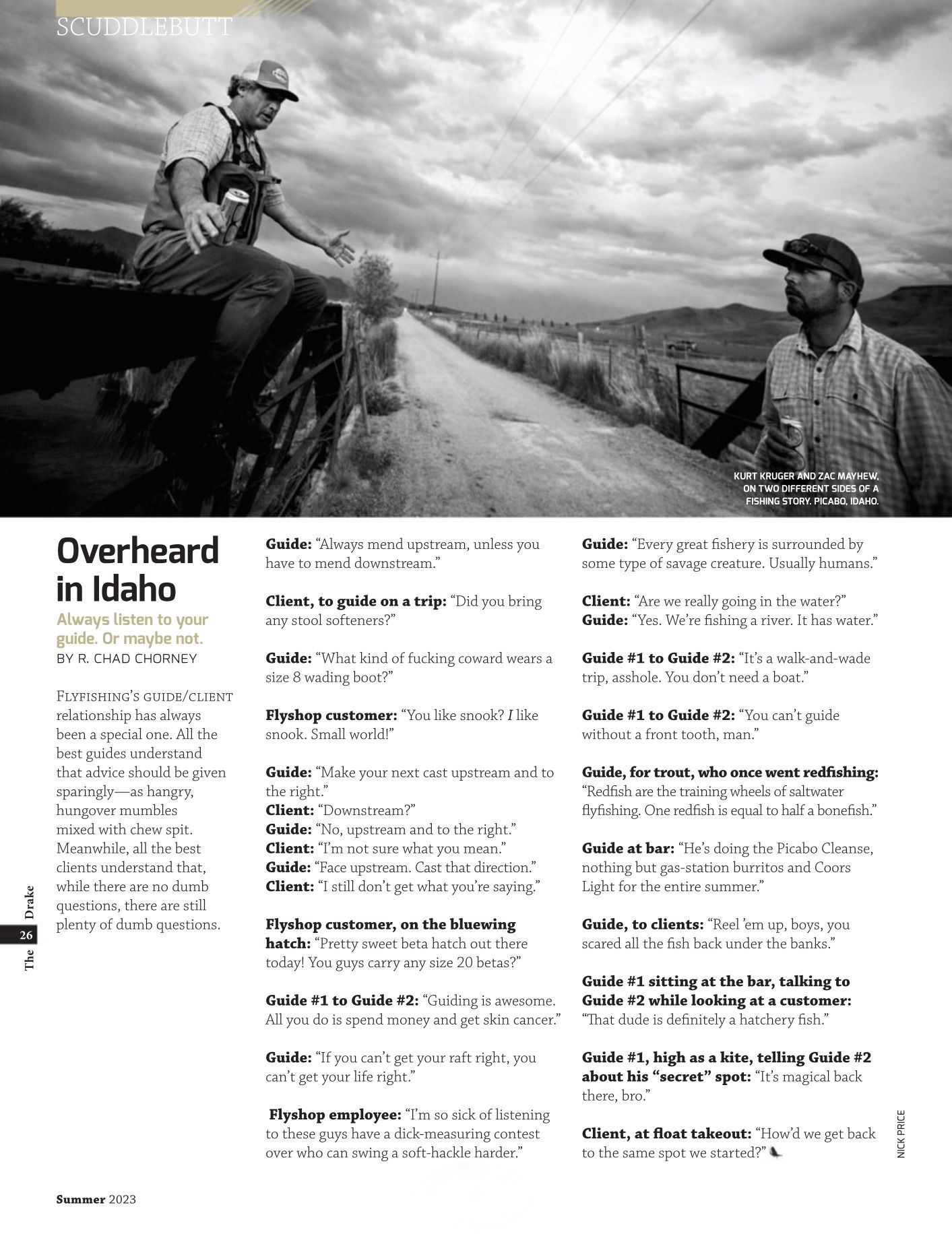
Intro to Fly Fishing: Voracious browns
We talk in class about different types of trout feeding behavior: on the surface, or subsurface. We talk about food, whether that’s insects, other fish, or whatever falls into the prey role that day.
Here are two examples of videos depicting the most visible and dramatic types of eats you’ll get: brown trout going after streamers.
Typically this is pre-spawn behavior, in the fall, where male browns come to full sexual maturity and develop their trademark kype, or hooked jaw, and a deep yellow color.
The technique is tried and true: cover a lot of water with big streamers splashed down and stripped quickly through target areas.
Still, watching the fish pursue the fly never gets old.
Project Healing Waters: In the NYT, Vintage Rod Auction
[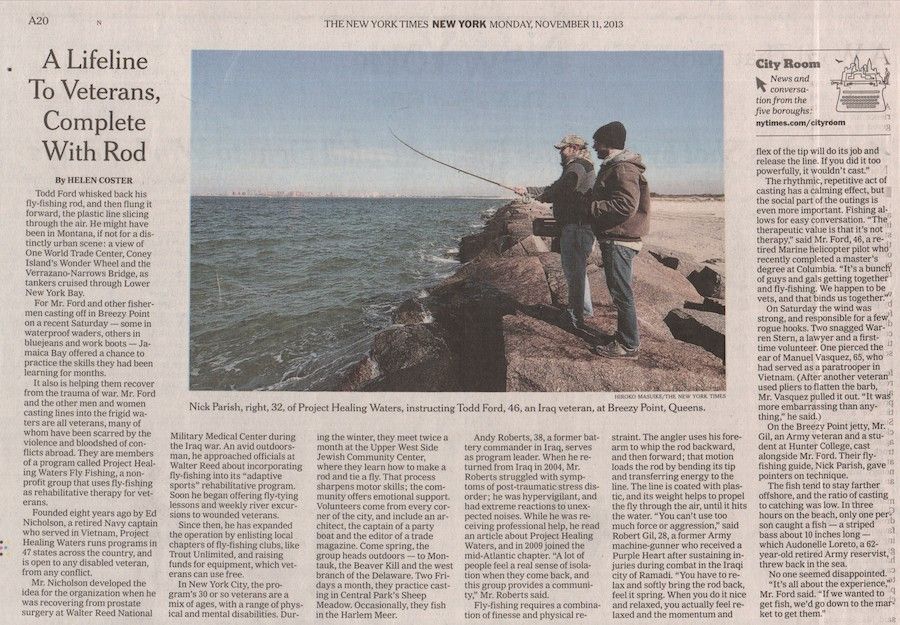
It was very exciting to see Project Healing Waters, an organization I do some volunteer work with, profiled by Helen Coster in The New York Times this year on Veterans Day. I would have never guessed the modifier that arrived along with my first appearance in the old grey lady would be “fly fishing guide,” but I’ll take it. I guess it’s a good impetus to finally get my casting instructor certification in order.
Please give the article a read to learn more about the sort of work we’re doing, and do get in touch if you’re interested.
We’ve had a huge outpouring of support since, including a bunch of people donating vintage fishing gear, which we resell to collectors to fund trips for vets. This has spurred us to organize a vintage rod auction.
There’s currently a great auction of vintage fiberglass and bamboo rods happening on eBay, from the collection of a man named Ed Travers. Ed’s rods, all in great condition, would make a wonderful holiday gift for the angler in your life, and a great way to give back to a worthy cause, so why not check them out? I’m helping administer the vintage rod auction, and will be posting new rods every Tuesday for the next few weeks, with five sets in all available. The first group of rods includes a homemade two-piece 8’-er and a seven weight Ted Williams model fiberglass rod in great condition.
If you can help spread the word, please do—let me know if there are any questions we can answer or help we can provide.
Icons: William James Lunn, River Keeper of the Test
 William James Lunn
William James Lunn
William James Lunn at work
I just finished River Keeper: The Life Of William James Lunn, by John Waller Hills, something the Literary Fly Fisher would no doubt appreciate. Originally published in 1934, I found it at my local library, although I was the first one to check it out since 1938.
The book concerns the decades William James Lunn spent in the early 20th century as the river keeper on the famous Test in Hampshire, England, specifically at the Houghton Club in Stockbridge.
Lunn’s life was certainly impressive: through perseverence and luck he escaped a life in factories, which began at age seven in a brickyard working sixteen hours a day, to eventually manage the fishery for a good 45 years.
His work was extensive, and chronicled in the book. Cutting grass, and repairing banks, rearing insects to be introduced or reintroduced into the river, rearing hatchling fish, battling predators: these are all duties that are described in detail.
For the gentlemanly type of fishing that went on (and still does) at the Test, this manicured comfort was essential. No wading, walk along the groomed lawn or path beside the river. Cast only a dry fly to feeding fish. A far cry from tactics used around the rest of the world.
The book is full of interesting anecdotes, how patterns were developed, curious rigs for breeding flies, the best food for trout to be stocked (a mixture of horseflesh and mussels, actually).
One of my favorite passages is towards the end:
Lunn taught me what I may call imaginative concentration. It is a common mistake to say that fishing needs patience. You should be impatient, never putting up with defeat. Patience is passive: you require the active virtue of concentration: but even this must keep your inventive faculties in play. Lunn’s eyes never left the water, and his mind never stopped thinking. He hated that laziness which disguises itself as activity, the energetic persistence in the use of a disregarded fly. Off with it, off with it at once, and the next too and the next until the fish either rises or removes himself. Lunn would no let me go on as I had gone on before and persevere with what I believed to be the best pattern and to persist after it had been refused. That is one way of fishing, and it often gets fish: after you have tried several likely flies, do not go on changing, but tie on the most likely, and stick with it. It is not a bad way, but it is not Lunn’s way. With him as your companion, you were continually changing your fly. If all your patterns were refused he would go back to an earlier one, at which the trout had given a friendly look: anyhow he would not let you continue with the same.
Inside the Anglers’ Club of New York
I had the good luck to be able to attend a small benefit dinner at the exclusive Anglers’ Club here in New York City a few weeks back. Well, it’s probably more accurate to say I snuck in on a technicality and managed to be pleasant enough that I wasn’t ejected.
The 106-year-old club, on Broad Street in the financial district, is crammed with history on the sport, counting as members some of its most prolific chroniclers and enthusiasts. It’s also very subdued in its operation. It doesn’t have a website. It doesn’t accept applications for membership (you have to be recommended, apparently). It doesn’t accept women.
The latest info I could find about the place is in this story about the club applying for a liquor license (see a PDF of the community board meeting minutes approving the license here) and a few words with the club’s director, Chris Matteson.
I’d love to see the club open up a bit and share some of its treasure trove with the wider world. If it had a blog delving into various items of its history, it’d be a hell of an interesting thing.
There’s one very special piece of Anglers’ Club-related history I saw that deserves its own post; here it is.
CFS Chat: George Daniel on Dynamic Nymphing
It’s only May, but George Daniel’s Dynamic Nymphing is already our favorite flyfishing book of 2012, and is likely to stay in the top spot. It’s the best sort: the kind that not only motivates you to go fishing, but gives you the tools to do the job better.
Daniel, who hails from central Pennsylvania and is the assistant manager of State College’s TCO Fly Shop, is one of the most highly lauded fly-fisherman in the country, earning all sorts of accolades competing and coaching internationally over the past decade. It’s unlikely the Denver Post’s Charlie Myers is exaggerating too highly when he says a compelling case can be made for Daniel as “the best fly-fisherman in the country” in one of the book’s blurbs.
Spend a few hours with Dynamic Nymphing and you’ll certainly agree, at least, that Daniel is among the sport’s most analytic. He delves into all the major elements of subsurface fishing, from rigging to casting to reading water and stocking your boxes. Daniel’s a systems thinker, and the book is a compendium of all the things he’s tried and tested over the course of his professional career.
This isn’t to say the approach is formulaic or dispassionate. Daniel peppers the instruction with anecdotes of his time on the water, of personalities he’s learned from, of the international fisherman he’s crossed paths with during his time traveling to fish competitively.
The end product is an enduring reference material without parallel, one that an active fisherman can take a few tips from here and there to bolster an existing archive of knowledge, or a newbie can use as a foundation to enter the sport. A number of elements of Daniel’s system have already crept into parts of our approach.
We were lucky enough to get some time with George (in between the Green Drake blitz, even!) and had the chance to ask him a few questions about his approach to the book.
CFS: How long did it take you to put the book together?
GD: The book project was a total of three and a half years, running everything from the outline to the final manuscript.
CFS: What was the process of putting it together?
GD: I had Jay Nichols from Stackpole and Headwaters contact me, and they had just followed a little of my career and heard me speak at a number of events and came to me and said “With all this information and these insights you’re bringing from different countries, it may be a good idea to put together a book.” We came up with a good outline and that’s basically it.
CFS: When did you first begin to focus on nymphing?
GD: When I joined the national team, I liked all aspects of flyfishing, but we would get video of people fishing, the Czechs, the Poles, a number of them, and as soon as I started watching these guys, it was really cool to see. It’s not revolutionary, but the small details, the elevation of the rod, the induced lift, the leader designs, all the things these guys were doing, were all slightly different. That sparked the fire in me, to take my game up and learn all the tips and tricks that these guys were employing.
CFS: If you had to pick one nymph method to use exclusively on all rivers, what technique would it be?
GD: I would probably say tight-lining. It’s a short-line version of high-sticking, the Czech or the Polish system. You have a more direct connection between the rod tip and the nymph. I was on Penns Creek yesterday, and the water was really rough, so I couldn’t get into position and I had to use an indicator. If I had a preference, at least where I fish here in central Pennsylvania, I’d go tight-line.

CFS: I assume with nothing rising you would always start with a nymph. What triggers you to switch from nymphs to dries? One fish rising? Ten fish rising?
GD: There’s a number of things to factor. Around here, I need to start seeing a fish rise every other minute to get my interest up. If I see an occasional rise, I’m going to stick to nymphing. But every other minute, the amount of effort is worth it. Last night, on Penns Creek, later in the evening, during the Green Drake hatch, I didn’t want to mess with nymphs. The takes are vicious, so I was just headhunting. Because naturally I enjoy the sight of a 14” or 15” brown inhaling a Green Drake off the surface.
CFS: If you had to fish with four nymph patterns exclusively on all rivers what would they be?
GD: Frenchie, Lance Egan’s, another one would be his Iron Lotus, another one would be his Rubber Leg Stonefly, and the fourth would be a little Zebra Midge, or some midge pattern.
CFS: A lot of what you talk about in the book is making sure your fly is in the right position. How do you know when your fly is in the zone? Are there any visual cues or tips to help shorten the learning curve?
GD: I like looking at the goal, you have a spot a fish that’s likely to hold, the primary zone. Typically you have your primary zone, where it’s likely to hold, and you have your secondary target, where you need to place the nymph to get to the primary zone. If they’re not even touching bottom there after one or two times, I’ll add weight, and if I’m hanging up every other cast, I’ll take some off. Cast into the secondary target to give it time to get to the primary target.
CFS: Why do you think competitive fly fishing has not taken off in the USA the way it has in Europe?
GD: I think there’s a lot of stigma with Bassmasters, but there are signs of it starting to take off. There’s a flyfishing forum and competitive league called TroutLegend where there are 500-600 active anglers, competitors. They have mini-comps, regional qualifiers on up. So it’s starting to grow a bit. In Scotland for example, we were fishing during the world championships, but all the lochs have local clubs, and they have weekly competitions. It’s a way for these guys to get out, and have a little camaraderie, share stories and tactics. These guys aren’t hoping to make a national team, just get out and share experiences and learn from each other, just like good old fishing buddies. It’s organized to get people together, and to create an interesting environment
CFS: You impart a lot of lessons from being exposed to other fly fishing cultures in the book, but what’s the main thing you’d say your time competing against other countries has taught you?
GD: The whole thing is simplicity. Basically, having organization in your system. Your fly boxes are organized, to the point where you have one working fly box with dries, nymphs, streamers. You can have thousands stashed somewhere, but you have one working box. It’s amazing how much quicker your decisions are made, compared to looking through four or five boxes. The good guys I come across fish out of one box, they have a system. Same with rods. One or two rods, they use them in just about every condition. Its like a relationship with a significant other, you know what buttons to push and what not to push. They know their equipment inside and out.
CFS: What about mentorship–it seems clear Joe Humphreys’ thinking has had a big influence on yours. What do you think the role of older mentors is in helping the sport progress?
GD: It’s incredible. When I coached the US youth team, it was amazing to me to see youths of 15 and 16 and how more advanced they were than I was, even in my early 20s. Look at athletes like swimmers, every year they get faster. But every year the quicker and the sooner we get kids information, they’re able to be better fly fishers. It’s amazing. I didn’t spent a ton of time fishing with Joe, maybe 10 times a year, but he gave me more encouragement than anything else. Having your fly fishing hero, your idol, saying he believes in you, that’s huge. If you have someone you respect and support, and they can give you encouragement, that can go a long way.
Again, we have nothing but high praise for Dynamic Nymphing_. It’ll change how you fish, for the better. Pick it up. And keep your eye on TCO’s site for details about George’s appearances. We can only imagine his expertise is imparted with just as much impact in person._
Inside the Angler’s Club of New York, Part 2
When I posted a few months ago about the Angler’s Club of New York, I neglected to tell one important anecdote that was relayed to me.
Now that Sandy’s left much of the New York City area underwater, the Angler’s Club’s fate seems like it would be uncertain. Fraunces Tavern, on the corner of Broad and Pearl streets, remains closed indefinitely. I would imagine the Angler’s Club, on the second floor, would be better off, but I haven’t been able to find any news of the relics inside, and the huge mass of books and papers and interesting lore it holds. Certainly, the old foundation of the building will be put to the test.
This isn’t the Angler’s Club’s first brush with a destructive fate, though. In 1975 the FALN, a terrorist group of Puerto Rican nationalists, attempted to plant a bomb in the tavern. They bombed the Angler’s Club instead. Four people eating lunch died in the attack. The article from the Sarasota Herald Tribune below has more.
In the rubble of that explosion, later, as club members were picking through, they found a letter to Theodore Gordon (below, full text in the Fly Fisher’s Reader, with more at Classic Trout) and accompanying flies in a trash heap, ready to be thrown away. It’s from Frederic Halford, and includes a number of flies used in British trout fishing. Gordon went on to adapt those patterns to the waters around New York, and many of the flies we tie today are based on them.
If this diamond could be rescued and restored, hopefully the same spirit will keep the Angler’s Club of New York bouyant through this hard time.
35 Inverness Terrace Hyde Park W February 22, 1890
Dear Sir: You must excuse my delay in replying to your favour of the 15th ult. I can quite imagine that in some parts of your country fish could be taken with dry fly where the more usual sunk fly would be of no avail–my difficulty however as to advising you of patterns likely to be successful is chiefly due to the fact that I have no knowledge of the streams or lakes nor of the genera and species of natural fly prevalent in them–hence I have thought it better to send you a few of the flies I use myself as patterns rather than order here what might prove after all useless to you–knowing your own rivers you can then select the patterns which seem likely and dress them yourself or order in the U.S.–if you prefer to have them dressed here and want my advice as to the best dresser I should recommend you giving your order to Mr. G. Holland–Bridge Street–Salisbury. If you tell him that the patterns were dressed for and by me and give the name he would be able to send you exactly what you wanted–in all case however give him the size of the hook and to assist you in this I have enclosed a set of the original size from 000 to 4. (Edit.–English system.) The shape of the hooks now made by Hutchison are to my mind an improvement on the original one as designed by my friend Mr. Hall–being more hackle only. If you should be unsuccessful with the floating flies or in doubt as to patterns please try and collect a few of the natural insects in sprit and send them to me by post and if I can dress imitations I will–a tube about 3” x 1” corked, quite full of methylated spirit packed with cotton wool in a small block of wood bored out to receive the tube will travel all over the world by post–of course the color does fade to a certain degree even in spirit but from experience I think I could allow for this and possibly even might know the genera and species– If I can be of any further assistance to you pray write and in any case kindly let me know the result of your experiments– With kind regards, Yours faithfully FREDERIC M. HALFORD THEODORE GORDON, ESQ.
Opening Day

Fun was had by all on the Willowemoc yesterday. Unfortunately, more covered bridges than fish were spotted. Low flows. Pray for rain.
